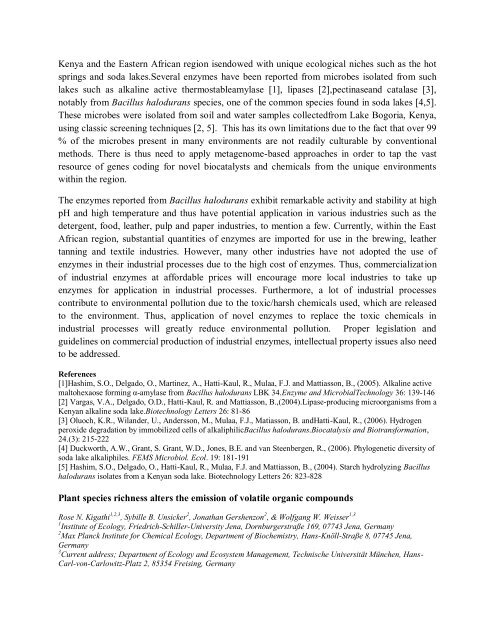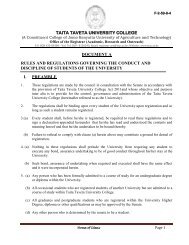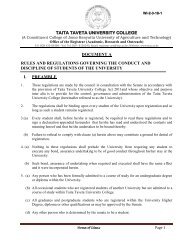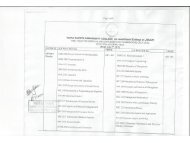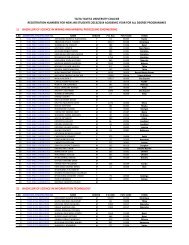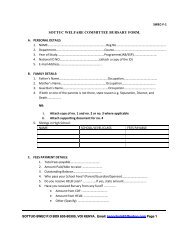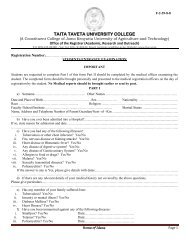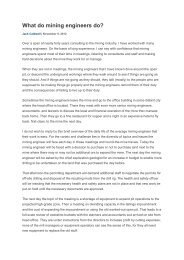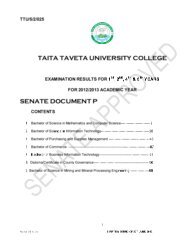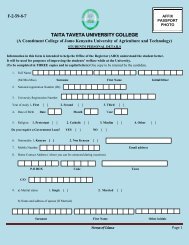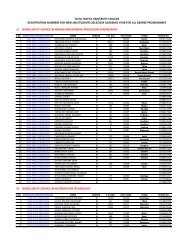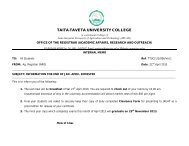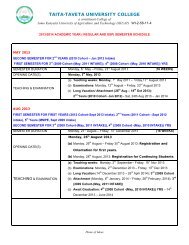Conference Book of Abstracts - Taita Taveta University College
Conference Book of Abstracts - Taita Taveta University College
Conference Book of Abstracts - Taita Taveta University College
- No tags were found...
Create successful ePaper yourself
Turn your PDF publications into a flip-book with our unique Google optimized e-Paper software.
Kenya and the Eastern African region isendowed with unique ecological niches such as the hotsprings and soda lakes.Several enzymes have been reported from microbes isolated from suchlakes such as alkaline active thermostableamylase [1], lipases [2],pectinaseand catalase [3],notably from Bacillus halodurans species, one <strong>of</strong> the common species found in soda lakes [4,5].These microbes were isolated from soil and water samples collectedfrom Lake Bogoria, Kenya,using classic screening techniques [2, 5]. This has its own limitations due to the fact that over 99% <strong>of</strong> the microbes present in many environments are not readily culturable by conventionalmethods. There is thus need to apply metagenome-based approaches in order to tap the vastresource <strong>of</strong> genes coding for novel biocatalysts and chemicals from the unique environmentswithin the region.The enzymes reported from Bacillus halodurans exhibit remarkable activity and stability at highpH and high temperature and thus have potential application in various industries such as thedetergent, food, leather, pulp and paper industries, to mention a few. Currently, within the EastAfrican region, substantial quantities <strong>of</strong> enzymes are imported for use in the brewing, leathertanning and textile industries. However, many other industries have not adopted the use <strong>of</strong>enzymes in their industrial processes due to the high cost <strong>of</strong> enzymes. Thus, commercialization<strong>of</strong> industrial enzymes at affordable prices will encourage more local industries to take upenzymes for application in industrial processes. Furthermore, a lot <strong>of</strong> industrial processescontribute to environmental pollution due to the toxic/harsh chemicals used, which are releasedto the environment. Thus, application <strong>of</strong> novel enzymes to replace the toxic chemicals inindustrial processes will greatly reduce environmental pollution. Proper legislation andguidelines on commercial production <strong>of</strong> industrial enzymes, intellectual property issues also needto be addressed.References[1]Hashim, S.O., Delgado, O., Martinez, A., Hatti-Kaul, R., Mulaa, F.J. and Mattiasson, B., (2005). Alkaline activemaltohexaose forming α-amylase from Bacillus halodurans LBK 34.Enzyme and MicrobialTechnology 36: 139-146[2] Vargas, V.A., Delgado, O.D., Hatti-Kaul, R. and Mattiasson, B.,(2004).Lipase-producing microorganisms from aKenyan alkaline soda lake.Biotechnology Letters 26: 81-86[3] Oluoch, K.R., Wilander, U., Andersson, M., Mulaa, F.J., Matiasson, B. andHatti-Kaul, R., (2006). Hydrogenperoxide degradation by immobilized cells <strong>of</strong> alkaliphilicBacillus halodurans.Biocatalysis and Biotransformation,24.(3): 215-222[4] Duckworth, A.W., Grant, S. Grant, W.D., Jones, B.E. and van Steenbergen, R., (2006). Phylogenetic diversity <strong>of</strong>soda lake alkaliphiles. FEMS Microbiol. Ecol. 19: 181-191[5] Hashim, S.O., Delgado, O., Hatti-Kaul, R., Mulaa, F.J. and Mattiasson, B., (2004). Starch hydrolyzing Bacillushalodurans isolates from a Kenyan soda lake. Biotechnology Letters 26: 823-828Plant species richness alters the emission <strong>of</strong> volatile organic compoundsRose N. Kigathi 1,2,3 , Sybille B. Unsicker 2 , Jonathan Gershenzon 2 , & Wolfgang W. Weisser 1,31 Institute <strong>of</strong> Ecology, Friedrich-Schiller-<strong>University</strong> Jena, Dornburgerstraße 169, 07743 Jena, Germany2 Max Planck Institute for Chemical Ecology, Department <strong>of</strong> Biochemistry, Hans-Knöll-Straße 8, 07745 Jena,Germany3 Current address; Department <strong>of</strong> Ecology and Ecosystem Management, Technische Universität München, Hans-Carl-von-Carlowitz-Platz 2, 85354 Freising, Germany


